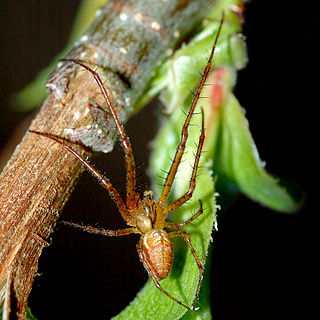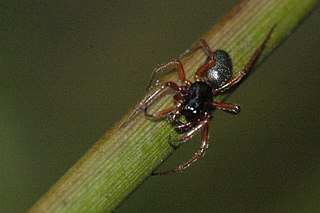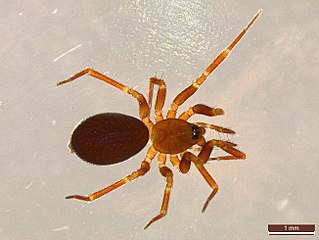
The family Dipluridae, known as curtain-web spiders are a group of spiders in the infraorder Mygalomorphae, that have two pairs of booklungs, and chelicerae (fangs) that move up and down in a stabbing motion. A number of genera, including that of the Sydney funnel-web spider (Atrax), used to be classified in this family but have now been moved to Hexathelidae.

Theridiidae, also known as the tangle-web spiders, cobweb spiders and comb-footed spiders, is a large family of araneomorph spiders first described by Carl Jakob Sundevall in 1833. This diverse, globally distributed family includes over 3,000 species in 124 genera, and is the most common arthropod found in human dwellings throughout the world.

Linyphiidae is a family of very small spiders comprising 4667 described species in 618 genera worldwide. This makes Linyphiidae the second largest family of spiders after the Salticidae. The family is poorly known; new genera and species are still being discovered throughout the world. The newest such genus is Yuelushannus from China, formally described in May 2020. Because of the difficulty in identifying such tiny spiders, there are regular changes in taxonomy as species are combined or divided.

Long-jawed orb weavers or long jawed spiders (Tetragnathidae) are a family of araneomorph spiders first described by Anton Menge in 1866. They have elongated bodies, legs, and chelicerae, and build small orb webs with an open hub with few, wide-set radii and spirals with no signal line or retreat. Some species are often found in long vegetation near water.

Dwarf sheet spiders (Hahniidae) is a family of araneomorph spiders, first described by Philipp Bertkau in 1878. Their bodies are about 2 millimetres (0.079 in) long, and they build extremely delicate webs in the form of a sheet. Unlike many spiders the web does not lead to a retreat. The silk used in these webs is so fine that they are difficult to spot unless they are coated with dew. They greatly favor locations near water or near moss, and are often found in leaf litter and detritus or on the leaves of shrubs and trees.

Hersiliidae is a tropical and subtropical family of spiders first described by Tamerlan Thorell in 1870, which are commonly known as tree trunk spiders. They have two prominent spinnerets that are almost as long as their abdomen, earning them another nickname, the "two-tailed spiders". They range in size from 10 to 18 mm long. Rather than using a web that captures prey directly, they lay a light coating of threads over an area of tree bark and wait for an insect to stray onto the patch. When this happens, they encircle their spinnerets around their prey while casting silk on it. When the insect is immobilized, they can bite it through the shroud.

Drapetisca is a genus of dwarf spiders that was first described by Anton Menge in 1866. Females are 4 to 5 millimetres long, and males are 3 to 4 millimetres long. They are common on tree trunks from July to September, and they feed on insects and smaller spiders.

Lasaeola is a genus of comb-footed spiders that was first described by Eugène Louis Simon in 1881. The type species was described under the name Pachydactylus pronus, but was renamed Lasaeola prona when it was discovered that the name "Pachydactylus" was preoccupied. Both this genus and Deliana were removed from the synonymy of Dipoena in 1988, but many of these species require more study before their placement is certain.

Lathys is a genus of cribellate araneomorph spiders in the family Dictynidae, and was first described by Eugène Simon in 1884. It is a replacement name for "Lethia" Menge, 1869 because that name was already in use as a synonym for a genus of moths.
Mastigusa is a genus of dwarf sheet spiders that was first described by Anton Menge in 1854. As of May 2019 it contains only three species: M. arietina, M. lucifuga, and M. macrophthalma.

Dicymbium is a genus of dwarf spiders that was first described by Anton Menge in 1868.

Gonatium is a genus of dwarf spiders that was first described by Anton Menge in 1868.

Helophora is a genus of dwarf spiders that was first described by Anton Menge in 1866.
Hypsocephalus is a genus of dwarf spiders that was first described by Alfred Frank Millidge in 1978.
Lasiargus is a genus of dwarf spiders that was first described by C. Chyzer & Władysław Kulczyński in 1894.

Lophomma is a genus of dwarf spiders that was first described by Anton Menge in 1868. As of May 2019 it contains only three species, found in Canada, Russia, and the United States: L. depressum, L. punctatum, and L. vaccinii.

Microneta is a genus of dwarf spiders that was first described by Anton Menge in 1869.
Syedra is a genus of sheet weavers that was first described by Eugène Louis Simon in 1884.













